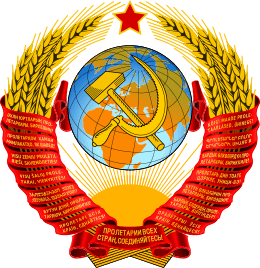Joint State Political Directorate
The Joint State Political Directorate (also translated as the All-Union State Political Administration and Unified State Political Directorate) was the secret police of the Soviet Union from 1923 to 1934. Its official name was "Joint State Political Directorate under the Council of People's Commissars of the USSR" (Russian: Объединённое государственное политическое управление при СНК СССР), Obyedinyonnoye gosudarstvennoye politicheskoye upravleniye pri SNK SSSR, or ОГПУ (OGPU).
| Объединённое государственное политическое управление при СНК СССР Obyedinyonnoye gosudarstvennoye politicheskoye upravleniye under the SNK of the USSR | |
| Agency overview | |
|---|---|
| Formed | 15 November 1923 |
| Preceding agency | |
| Dissolved | 10 July 1934 |
| Superseding agency | |
| Type | Secret police |
| Headquarters | 11-13 ulitsa Bol. Lubyanka, Moscow, RSFSR, USSR |
| Agency executives |
|
| Parent agency | Council of the People's Commissars |
With the formation of the Soviet Union in December 1922, a unified organization was required to exercise control over state security throughout the new union. Thus, on November 15, 1923, the State Political Directorate left the Soviet NKVD and came directly under the Council of People's Commissars as the all-union Joint State Political Directorate. Felix Dzerzhinsky, chairman of the GPU, became the OGPU's first chief.
Like the GPU before it, the OGPU operated - in theory - with more restraint than the original Bolshevik secret police, the Cheka of 1917-1922. Unlike the Cheka, the OGPU could not shoot "counter-revolutionaries" at will, and most suspected political criminals had to be brought before a judge. The OGPU's powers increased greatly in 1926, when the Soviet criminal code was amended to include a section on anti-state terrorism. The provisions were vaguely written and very broadly interpreted. Even before then, OGPU had set up tribunals to try the most exceptional cases of terrorism, usually without calling any witnesses.[1] In time, the OGPU's de facto powers grew even greater than those of the Cheka.
The GPU/OGPU achieved perhaps its most spectacular success with the Trust Operation of 1924–1925. OGPU agents contacted émigrés in western Europe and pretended to represent a large group, known as "the Trust", working to overthrow the communist régime. Exiled Russians gave "the Trust" large sums of money and supplies, as did foreign intelligence agencies. Soviet agents finally succeeded in luring one of the leading anticommunist operators, Sidney Reilly, into Russia to meet with the Trust. Once in the Soviet Union (September 1925), he was captured and murdered. The Trust was then dissolved, having become a huge propaganda success.
From 1927 to 1929 the OGPU engaged in intensive investigations of an opposition coup. Stalin issued a public decree that any and all opposition views should be considered dangerous and gave the GPU the authority to seek out hostile elements. That led in March 1928 to the Shakhty Trial, which saw the prosecution of a group of supposed industrial saboteurs allegedly involved in a hostile conspiracy. That would be the first of many trials during Stalin's rule.
The OGPU planned and set up the Gulag system. It also became the Soviet government's arm for the persecution of the Russian Orthodox Church, the Greek Catholics, the Latin Catholics, Islam and other religious organizations, in an operation headed by Yevgeny Tuchkov. The OGPU was also the principal secret-police agency responsible for the detection, arrest, and liquidation of anarchists and other dissident left-wing factions in the early Soviet Union.
GPU brigades led Soviet forces in the 1934 Soviet invasion of Xinjiang.[2]
The OGPU was reincorporated into the newly created all-union People's Commissariat for Internal Affairs (NKVD) in July 1934, becoming its Main Directorate of State Security (GUGB). It subsequently became the more widely known Committee for State Security (KGB).
See also
| Wikimedia Commons has media related to Joint State Political Directorate, USSR (OGPU). |
References
- Overy, Richard (2004). The Dictators: Hitler's Germany, Stalin's Russia. London: W. W. Norton. ISBN 978-0393020304.
- Andrew D. W. Forbes (1986). Warlords and Muslims in Chinese Central Asia: a political history of Republican Sinkiang 1911–1949. Cambridge, England: Cambridge University Press Archive. p. 120. ISBN 978-0-521-25514-1. Retrieved 2010-06-28.
